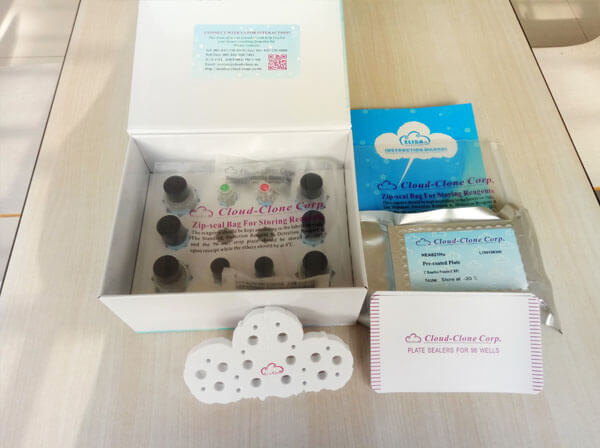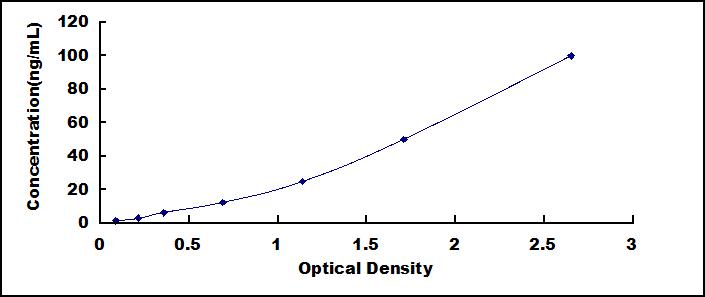High Sensitive ELISA Kit for Apolipoprotein B (APOB) 

Apo-B; FLDB; Apo B-100
- UOM
- FOB US$ 431.00 US$ 616.00 US$ 2,772.00 US$ 5,236.00 US$ 43,120.00
- Quantity
Overview
Properties
- Product No.HEC003Hu
- Organism SpeciesHomo sapiens (Human) Same name, Different species.
- ApplicationsEnzyme-linked immunosorbent assay for Antigen Detection.
Research use only - DownloadInstruction Manual
- CategoryMetabolic pathwayEndocrinologyCardiovascular biologyHepatologyNutrition metabolism
Sign into your account
Share a new citation as an author
Upload your experimental result
Review

Contact us
Please fill in the blank.
Recovery
Matrices listed below were spiked with certain level of recombinant High Sensitive Apolipoprotein B (APOB) and the recovery rates were calculated by comparing the measured value to the expected amount of High Sensitive Apolipoprotein B (APOB) in samples.
| Matrix | Recovery range (%) | Average(%) |
| serum(n=5) | 78-92 | 81 |
| EDTA plasma(n=5) | 89-99 | 93 |
| heparin plasma(n=5) | 90-97 | 94 |
Precision
Intra-assay Precision (Precision within an assay): 3 samples with low, middle and high level High Sensitive Apolipoprotein B (APOB) were tested 20 times on one plate, respectively.
Inter-assay Precision (Precision between assays): 3 samples with low, middle and high level High Sensitive Apolipoprotein B (APOB) were tested on 3 different plates, 8 replicates in each plate.
CV(%) = SD/meanX100
Intra-Assay: CV<10%
Inter-Assay: CV<12%
Linearity
The linearity of the kit was assayed by testing samples spiked with appropriate concentration of High Sensitive Apolipoprotein B (APOB) and their serial dilutions. The results were demonstrated by the percentage of calculated concentration to the expected.
| Sample | 1:2 | 1:4 | 1:8 | 1:16 |
| serum(n=5) | 85-103% | 94-103% | 89-96% | 80-95% |
| EDTA plasma(n=5) | 98-105% | 95-103% | 78-93% | 98-105% |
| heparin plasma(n=5) | 91-104% | 95-102% | 78-90% | 91-103% |
Stability
The stability of kit is determined by the loss rate of activity. The loss rate of this kit is less than 5% within the expiration date under appropriate storage condition.
To minimize extra influence on the performance, operation procedures and lab conditions, especially room temperature, air humidity, incubator temperature should be strictly controlled. It is also strongly suggested that the whole assay is performed by the same operator from the beginning to the end.
Reagents and materials provided
| Reagents | Quantity | Reagents | Quantity |
| Pre-coated, ready to use 96-well strip plate | 1 | Plate sealer for 96 wells | 4 |
| Standard | 2 | Standard Diluent | 1×20mL |
| Detection Reagent A | 1×120µL | Assay Diluent A | 1×12mL |
| Detection Reagent B | 1×120µL | Assay Diluent B | 1×12mL |
| TMB Substrate | 1×9mL | Stop Solution | 1×6mL |
| Wash Buffer (30 × concentrate) | 1×20mL | Instruction manual | 1 |
Assay procedure summary
1. Prepare all reagents, samples and standards;
2. Add 100µL standard or sample to each well. Incubate 1 hours at 37°C;
3. Aspirate and add 100µL prepared Detection Reagent A. Incubate 1 hour at 37°C;
4. Aspirate and wash 3 times;
5. Add 100µL prepared Detection Reagent B. Incubate 30 minutes at 37°C;
6. Aspirate and wash 5 times;
7. Add 90µL Substrate Solution. Incubate 10-20 minutes at 37°C;
8. Add 50µL Stop Solution. Read at 450nm immediately.

Test principle
The test principle applied in this kit is Sandwich enzyme immunoassay. The microtiter plate provided in this kit has been pre-coated with an antibody specific to High Sensitive Apolipoprotein B (APOB). Standards or samples are then added to the appropriate microtiter plate wells with a biotin-conjugated antibody specific to High Sensitive Apolipoprotein B (APOB). Next, Avidin conjugated to Horseradish Peroxidase (HRP) is added to each microplate well and incubated. After TMB substrate solution is added, only those wells that contain High Sensitive Apolipoprotein B (APOB), biotin-conjugated antibody and enzyme-conjugated Avidin will exhibit a change in color. The enzyme-substrate reaction is terminated by the addition of sulphuric acid solution and the color change is measured spectrophotometrically at a wavelength of 450nm ± 10nm. The concentration of High Sensitive Apolipoprotein B (APOB) in the samples is then determined by comparing the O.D. of the samples to the standard curve.
Giveaways
Increment services
Citations
- Group 1B phospholipase A2 deficiency protects against diet-induced hyperlipidemia in miceJlr: M019463
- Elevated retinol binding protein 4 induces apolipoprotein B production and associates with hypertriglyceridemiaPubmed:25781360
- Culturing of HepG2 cells with human serum improve their functionality and suitability in studies of lipid metabolismPubMed: 26515253
- Hypoascorbemia induces atherosclerosis and vascular deposition of lipoprotein (a) in transgenic micePubMed: 26064792
- Proprotein convertase subtilisin/Kexin type 9 (PCSK9) single domain antibodies are potent inhibitors of LDL receptor degradationPubmed:27284008
- COMPOSITIONS AND METHODS FOR EFFICACIOUS AND SAFE DELIVERY OF SIRNA USING SPECIFIC CHITOSAN-BASED NANOCOMPLEXESy2016:0152988.html
- Hops (Humulus lupulus) Content in Beer Modulates Effects of Beer on the Liver After Acute Ingestion in Female Mice.pubmed:27659607
- Change in the Lipid Transport Capacity of the Liver and Blood during Reproduction in Ratspubmed:28798692
- Wild Lonicera caerulea berry polyphenol extract reduces cholesterol accumulation and enhances antioxidant capacity in vitro and in vivoPubmed:29580541
- Consumption of orange fermented beverage improves antioxidant status and reduces peroxidation lipid and inflammatory markers in healthy humansPubmed:29124773
- The effect of exenatide (a GLP-1 analog) and sitagliptin (a DPP-4 inhibitor) on plasma platelet-activating factor acetylhydrolase (PAF-AH) activity and concentration in?…Pubmed: 30768981
- Hepatic HuR modulates lipid homeostasis in response to high-fat dietPubmed: 32546794
- Study of in Vivo Serum Lipid Regulation with Ulmus macrocarpa Hance Extract in Rats
- GP73 is a TBC-domain Rab GTPase-activating protein contributing to the pathogenesis of non-alcoholic fatty liver disease without obesity34853313















